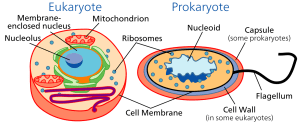Unit 2.10: Cell Compartmentalization
The Efficiency of Eukaryotic Cells Through Compartmentalization
One of the defining characteristics of eukaryotic cells is compartmentalization. Unlike prokaryotic cells, eukaryotes contain membrane-bound organelles, allowing them to perform complex processes efficiently and in an organized manner. This distinction is a key reason why eukaryotic cells are more advanced and capable of handling intricate biological tasks.
In eukaryotic cells, after RNA is synthesized from DNA in the nucleus through transcription, it must travel to the ribosomes for translation. This movement occurs from the nucleus to either a free ribosome or a ribosome attached to the rough endoplasmic reticulum (ER), where protein synthesis takes place. Additionally, ATP (adenosine triphosphate) is produced within the mitochondria, an organelle that features its own internal membranes specifically designed to optimize energy production.
In contrast, prokaryotic cells lack compartmentalization. They do not possess a nucleus or an endoplasmic reticulum. Instead, transcription and translation occur almost simultaneously without the need for specialized compartments. This fundamental difference between prokaryotic and eukaryotic cells significantly affects the efficiency of their cellular processes.
Benefits of Cell Compartmentalization
The compartmentalization of eukaryotic cells offers several distinct advantages:
Reduction of Competing Reactions: By localizing different cellular processes within specific organelles, eukaryotic cells reduce interference between different biochemical reactions. This separation ensures that each organelle can optimize its internal environment for the specific processes it facilitates.
Increased Efficiency: Compartmentalization means that eukaryotic cells can perform multiple functions simultaneously without cross-interference. For example, while mitochondria generate ATP, the endoplasmic reticulum can focus on synthesizing and modifying proteins without any disruptions.
Enhanced Surface Area: Many internal membranes within organelles, such as those in the mitochondria and chloroplasts, are folded to increase their surface area to volume ratio. These folds—such as the cristae in mitochondria and thylakoids in chloroplasts—maximize space for biochemical reactions, enhancing the efficiency of processes like ATP synthesis and photosynthesis.
Internal Membranes and Surface Area
A key theme throughout cellular biology is the importance of surface area to volume ratio. Internal membranes provide eukaryotic cells with additional surfaces for critical biochemical reactions. For instance, in the mitochondria, ATP synthesis occurs across the inner membrane. By folding the membrane, the cell ensures that there is more surface area for essential reactions, leading to more efficient energy production.
Key Takeaways
Eukaryotic Cells: Compartmentalization allows eukaryotic cells to carry out complex biochemical reactions in a more organized and efficient manner. Each organelle is specialized, reducing competition for space and minimizing the chances of conflicting interactions.
Prokaryotic Cells: In contrast, prokaryotes lack internal membranes, which makes their processes more straightforward but less efficient. They rely on a more basic method of protein production, where RNA is immediately translated into proteins without the compartmental separation seen in eukaryotes.

Why Compartmentalization Matters
Ultimately, the efficiency of eukaryotic cells is largely due to their ability to compartmentalize. By isolating different cellular functions, eukaryotic cells can optimize the internal conditions for each task, thereby ensuring that they can meet the demands of more complex organisms.
⚡ Watch: Dive deeper into cell compartmentalization by watching our AP Biology video on [Cell Compartmentalization].
Explore More: Check out our AP Bio Unit 2 replays or the 2021 Unit 2 Cram for a comprehensive understanding of eukaryotic cell efficiency.
Quick Question
Why does compartmentalization make eukaryotic cells more efficient than prokaryotic ones?
By having more organelles within them
Due to their larger size compared with prokaryotic cells
By reducing competing space and reactions, while increasing surface area to volume ratio
Because they have a nucleus housing genetic material
The correct answer emphasizes the role of compartmentalization in reducing competition for resources and increasing the surface area available for vital cellular reactions.
Key Terms to Review
ATP (Adenosine Triphosphate): The primary energy carrier in cells.
Cell Compartmentalization: The use of internal membranes to separate different biochemical processes within eukaryotic cells.
Surface Area to Volume Ratio: A crucial factor in cell biology, determining the efficiency of material exchange and biochemical processes.
Mitochondria and Chloroplasts: Organelles with specialized internal membranes that aid in energy production and photosynthesis, respectively.








